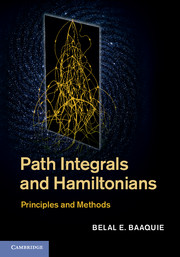Book contents
- Frontmatter
- Dedication
- Contents
- Preface
- Acknowledgements
- 1 Synopsis
- Part one Fundamental principles
- Part two Stochastic processes
- Part three discrete degrees of freedom
- Part four Quadratic path integrals
- Part five Action with acceleration
- 13 Accelaration Lagrangian
- 14 Pseudo-Hermitian Euclidean Hamiltonian
- 15 Non-Hermitian Hamiltonian: Jordan blocks
- Part six Nonlinear path integrals
- References
- Index
14 - Pseudo-Hermitian Euclidean Hamiltonian
from Part five - Action with acceleration
Published online by Cambridge University Press: 05 April 2014
- Frontmatter
- Dedication
- Contents
- Preface
- Acknowledgements
- 1 Synopsis
- Part one Fundamental principles
- Part two Stochastic processes
- Part three discrete degrees of freedom
- Part four Quadratic path integrals
- Part five Action with acceleration
- 13 Accelaration Lagrangian
- 14 Pseudo-Hermitian Euclidean Hamiltonian
- 15 Non-Hermitian Hamiltonian: Jordan blocks
- Part six Nonlinear path integrals
- References
- Index
Summary
There is no conservation of probability in the Euclidean formulation of the acceleration Lagrangian. A narrow definition of a Hamiltonian, and the one that holds in quantum mechanics but is not suitable for our case, is that the Hamiltonian defines a probability conserving unitary evolution. A broader definition of the Hamiltonian is adopted that is consistent with both statistical mechanics and quantum mechanics. Namely, the Hamiltonian – which is equivalent to the transfer matrix in statistical mechanics – is the generator of infinitesimal translations in time for both the Minkowski and Euclidean cases.
The Hamiltonian derived for the acceleration Lagrangian in Chapter 13 is studied in this chapter using the concepts of the state space and operators. The Hamiltonian for unequal and real frequencies ω1,ω2 is pseudo-Hermitian and is explicitly mapped to a Hermitian Hamiltonian using a nontrivial differential operator. An explicit expression is obtained for the matrix element of the differential operator. The mapping fails for a critical value of the coupling constants.
The Hamiltonian and state space are shown to have real and complex branches that are separated by the critical point. At the critical point, the Hamiltonian is inequivalent to any Hermitian operator, and is shown in Chapter 15 as being equal to an infinite-dimensional block diagonal matrix, with each block being a Jordan matrix.
- Type
- Chapter
- Information
- Path Integrals and HamiltoniansPrinciples and Methods, pp. 294 - 329Publisher: Cambridge University PressPrint publication year: 2014



